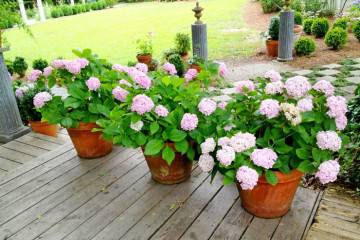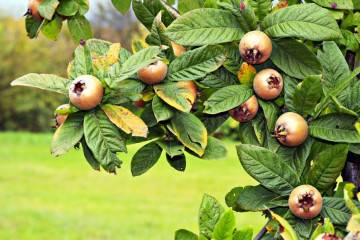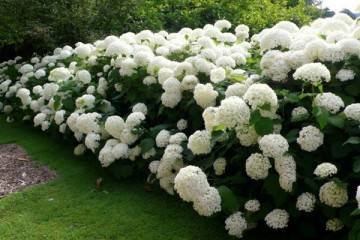Lemon tree - houseplant care
Content:
Lemon is one of the favorite fruits of people, many people like its aroma. Therefore, the opportunity to have an indoor lemon at home is very attractive to some domestic housewives. This article will tell you in detail about the features of growing this interesting tree, and will help you find answers to a number of questions about caring for it.
Lemon tree: what it looks like
The room lemon is a citrus fruit with a history that goes deep into the past. The name "lemon" comes from the Malay word "lemo", which means "good for mothers." This fruit does not have an exact deposit, according to historians, China or India may be the homeland.
It is noteworthy that the leaves of the lemon tree are no less healing than the lemon itself. They benefit the human body and have properties useful for it:
- regenerative;
- astringent;
- choleretic;
- healing;
- antiviral;
- antibacterial.
Also, these leaves increase resistance against viruses, improve blood circulation, in case of infection, accelerate a person's recovery.
How does homemade lemon grow? With the right attitude, it quickly reaches the desired height and begins to bear fruit. The exact term for this is different for each variety.
Popular varieties of homemade lemon tree
Many people are wondering which kind of lemon is better suited for the interior, which one looks more beautiful. A description of the most interesting varieties is below.
Panderosa
The Panderosa lemon tree variety is a cross of grapefruit, citron, pompelmus and lemon.
This variety is very compact and, due to its small size, is often confused with a decorative flower. The height of this plant reaches one and a half meters (dwarf plant).
The main feature of this species is huge fruits (in natural conditions, about 500 grams in weight, at home 100-200). Due to its size and bumpy surface, it is very similar to citron. Panderoza has a large leaf size - 15 × 8 cm.
Kievsky
The Kiev variety of lemon tree is similar in size to Panderoza, they are called "Cosmopolites" - the old common citruses, the names of which are known everywhere.
The first flowering is observed already at 1 year of life, homemade lemon can bear fruit about 4 times a year, the weight of the fruit is mainly 50-70 grams.
The plant is medium in height - from 1.5 to 2.5 meters in height, with a lush crown. Good for home cultivation.
Pavlovsky
Pavlovsky variety of lemon tree resembles a small bush from the side, about 1-1.5 meters high, very rarely reaches 2 meters.
The fruit of this variety fills the room with a pleasant, tart smell. Its aroma prevents infection with all sorts of diseases. The leaves also have healing properties and can be brewed and drunk like tea.
It has been proven that the phytoncides released by it disinfect and purify the air, and they also soothe nerve endings, relieve fatigue. This indoor lemon attracts people's eyes, fits well into the decor of the apartment. Pavlovsky lemon looks organically in offices, houses, creating a unique healing atmosphere there. All this is complemented by the dazzling yellowness of the fruit.
Meyer
The Meyer lemon tree has very compact, bright fruits that play the role of a highlight in the room. This lemon begins to bear fruit when it is 4 or 5 years old. It reaches a height of up to 1.5 meters.
A certain disadvantage is that this tree grows in the form of a bush. During the winter period, this homemade lemon loses a small amount of leaves, but these are only temporary losses, closer to spring they grow back.
Meyer's lemon is very easy to distinguish from others, its weight ranges from 80-120 grams, it has a bright yellow color, when cut it resembles an orange.
Most often, indoor lemon lovers note its acidity, but this is not the case. The truly ripe Mayer Lemon is the sweetest of all the sunny plant varieties. But behind every beauty there is a sea of whims, and this plant is no exception.
Genoa
This variety is one of the tastiest of the lemon variety. The growth of this tree in a greenhouse can reach 3 meters, and in rooms - up to one and a half meters.
The crown is symmetrical, does not require shaping. Genoa is considered the record holder for foliage density, while the shape of the plates resembles an egg.
Lemon tree: home care
The lemon tree requires a reverent attitude towards itself, competent care at home. The natural habitat of this citrus representative is not at all similar to the conditions that are created in apartments.
Lighting and temperature
This tree is very picky about light and for successful development it must be placed near a window under diffused light. In the summer, you need to transfer the lemon to fresh air (balcony), if this is not possible, then you can take the tree deeper into the room, where the scorching rays of the sun, which can scorch the foliage, will not reach.
In the cold season, at an average temperature of 7-14 degrees, the lemon falls asleep, the growth processes stop. The dormant period is very important for the plant. Only after a good rest, the lemon will be able to bear fruit.
This plant does not like sudden changes in temperature. Do not transfer it to a warm room during the onset of frost. It is necessary to change its habitat gradually. If it so happened that the cold came suddenly, you need to slowly reduce the average temperature around it.
Watering rules and humidity
For absolutely all varieties of indoor lemon, one rule applies: every 5-7 days, the lemon needs to be watered with 11.5 liters of water.
Lemon loves rare but deep watering. The best time to irrigate is early morning or evening. In this case, the water will not evaporate from the rays of the sun, but will have time to become the same temperature as the roots.
The amount of water to be poured can vary depending on the room temperature, the dryness of the soil and also on the size of the pot. In general, you need to monitor the condition of the land. If the soil is dry to a depth of 2-3 cm, then water the lemon.
If the weather is very hot (t over +29 for several days), then the intensity of watering is increased. In such conditions, it is permissible to water the tree every other day.
The lemon tree loves humid air. With a dry atmosphere in the room, the leaves begin to fall off the tree. To avoid this, you need to try to maintain a relatively high humidity in the room, about 60%.You can spray the leaves with water, preferably lukewarm, or use a humidifier in the room.
Top dressing
Everyone wants to see a healthy, beautiful, constantly growing lemon tree, and in order to contemplate progress, it needs to be properly looked after. Even the most fertile soil after 3-4 months depletes its reserves of nutrients: nitrogen, phosphorus, potassium, calcium. Therefore, you need to fertilize the soil.
Plant feeding rules:
- at the beginning of spring, it is required to feed the lemon with nitrogen to build up the green mass;
- in May, the need for nitrogen drops dramatically, so it is worth feeding the lemon with urea (1.5 grams) with the addition of microelements: magnesium, boron, copper (it is best if it is some kind of complex mixture);
- in the first month of summer, it is required to add superphosphate (5 grams) and potassium sulfate (3 grams) to the soil;
- in the third month of summer, you need to return to fertilization with a manure mixture (100 grams), with a small pinch of manganese (0.2 g);
- at the beginning of autumn, you need to feed the plant with complex fertilizers;
- closer to winter, phosphorus is needed again;
- during winter, it is enough to carry out surface top dressing with potassium permanganate using a sprayer.
To avoid a variety of diseases, you need to spray this citrus with a weak manganese solution.
On the forums of plant lovers, they are often interested in why the leaves of indoor lemon turn yellow and what needs to be done in this case. To avoid this, you need to regularly feed the citrus tree with fertilizers. They significantly enhance the immunity of the plant, help to cope with diseases and pests.
Soil quality
The soil for such an unusual home plant as the lemon tree must be balanced: acidity, looseness, lightness, water permeability and air permeability of average values.
Clay soil, like light peat soil, will not suit this capricious tree. The best soil for lemon is considered to be nutritious loam with the addition of sand.
The indoor tree does not like strongly or weakly acidic soils. Neutral ground (Ph 6.5-7) is the best option.
Flower container size
Before you start growing homemade lemon, you need to responsibly choose the container. There are three types of pots: wood, plastic, and clay.
- Clay. Experienced growers say that a clay pot is the best choice for planting a plant like lemon. This begs the question: why? Clay is a natural material, it absorbs excess moisture and serves as a small protection against decay. By themselves, clay pots look organic, easily fit into any interior. There are also disadvantages: clay is very fragile, roots often grow together with the pot, high evaporation rate of moisture, salts are deposited at the walls.
- Plastic. Such pots are much cheaper than clay pots, they are stronger than their competitors, more durable. You can also choose the design of your choice. The problem that roots can grow to the pot is eliminated. But this also has its drawbacks: plastic does not allow moisture to pass through, which can cause tree roots to rot, and the material is very light and a large tree can fall even with a small gust of wind or an accidental jolt.
- Wood. Wooden pots include the advantages of the previous 2 types, but there are disadvantages everywhere. From moisture, the tree is very deformed and wears out, which makes this type of pot short-lived. At the bottom of such a pot, there must be a drainage layer of gravel.
How to choose a pot size? Seedlings of the 1st year are planted in pots with a diameter of 10-15 cm. You cannot use large pots, in such conditions the lemon can rot. Each new pot (changed during transplantation) should exceed the diameter of the old one by 2-3 cm.
Flowering lemon tree
How does lemon bloom at home? The lemon tree is one of the most popular window sill plants for flower growers. Its bloom is a rather unusual, but very colorful process, during which a sweet smell spreads throughout the room. However, you need to make a huge amount of effort to make the indoor lemon bloom.
What does it take for a lemon to bloom? Maintain certain conditions of detention:
- a favorable atmosphere, clean air is needed;
- light must fall on the lemon for at least 12 hours a day;
- watch out for excess leaves, constantly cut them off;
- regularly feed the plant with fertilizers;
- water regularly, preferably with purified, settled water at room temperature.
Reproduction of indoor lemon
You need to propagate this type of plant by cuttings. Any time of the year is suitable, but the best results are obtained in March-April.
You need to take cuttings from a lemon, the next growth cycle of which has already ended. The cuttings should be firm, green and pliable. Before you cut the twig, the knife should be disinfected so as not to damage the plant in any way. In this case, it is advisable to take the knife as sharp as possible.
The stalk should be 8-10 cm long and have at least 3-4 leaves. For planting such a cutting, it is advisable to use soil consisting of sphagnum moss and sand. Sphagnum can be exchanged for high moor peat, if necessary.
Step-by-step planting process:
- The bottom of the tank is covered with a small layer of drainage.
- Then you need to put a solid layer of earth.
- Then put the mixed moss and sand.
Until the cutting takes root into the ground, it must be constantly sprayed. About 2 times a day. It is necessary to independently make a greenhouse from a plastic bag, which will allow the sun's rays to pass through. After 1-2 weeks, you can accustom the seedling to room air. After 2-3 weeks, the sprout can be transplanted into a pot with a diameter of 9-10 centimeters.
How to plant indoor lemon at home
Sooner or later every lemon owner will ask this question: how to plant a lemon? Vaccination of a lemon requires experience, you should not be upset if you did not succeed in doing this the first time. None of the methods can promise a guaranteed result.
The method of budding in stages:
- The trunk of the tree is gently wiped with a cloth, after which cuts are made in the bark in the form of a letter "T" (horizontal cut 1 cm, the second down, the length of which should be 2.5 cm, you cannot cut the core).
- Cut off the eyelet. The main thing is that the bark is visible from the back.
- Attach wood tightly.
- The operation site must be wrapped with a specialized tape so that the peephole remains visible.
The cleft grafting method is performed as follows:
- Gently wipe the stock and seedling.
- Cut the tree from top to bottom 5-10 cm from the ground (preferably with pruning shears).
- With a sharp knife, cuts are made in the stalk with a depth of 2-3 cm.
- At the place where one plant is grafted onto another, two oblique cuts of about 2.5 - 3 cm are made.
- Insert the branch into the split made.
- The site of the operation is wrapped.
How to care for a plant after vaccination
Postoperative care is an important procedure for a healthy future tree.
- on the scion, it is important to remove all unnecessary sheets;
- organize a greenhouse, either with a glass beaker or with a bag (transparent);
- such a greenhouse needs to be aired twice a day for 2-3 minutes;
- high humidity should be created (you can put a wet cotton swab inside the greenhouse);
- if after 14-15 days the leaf petioles can be easily separated, then the vaccination is successful and the bandage can be loosened;
- if the stalk has turned black, then the attempt is unsuccessful and will have to be grafted again.
In total, the vaccination procedure takes about 3 weeks.
Possible problems in growing lemon trees
Indoor lemon is an amazing plant that can decorate any room. Whether it's an office or just a living room.
However, when growing it, you can face some problems:
- Pests. Most often, this plant is attacked by the scale insect, after which protruding oval plates form on the leaves. To get rid of this parasite, modern drugs should be used: Aktara, Actellik. If the plant is attacked by a tick, then the plant should be sprayed with sulfur, or pesticides should be applied. The plant can also attack aphids. In this case, you need garlic water. The crushed head of garlic is placed in a glass of hot water and infused for about 2 days. The tree is sprayed with ready-made infusion every other day for a week. After 5 days, the procedure is repeated.
- Sometimes the lemon sheds its leaves. This is most often due to the small amount of sunlight.
- The yellowing and drying of the leaves is mainly due to the large number of pests. Also, due to the lack of moisture, the plant will dry out. I want to change the watering schedule for the plant.
- The wilting of the plant can be due to both insects and a draft.
- With excessive watering, the roots of the plant begin to rot. The decay process is not immediately visible, but the leaves begin to lose turgor. If this happens, you need to remove the plant from the container, rinse the roots, cut off rotten areas, treat the cut sites with activated carbon. Next, the room lemon must be planted in a new container using fresh soil.
Indoor lemon is a pretty plant that requires a very reverent attitude towards itself. But growing it is not that difficult. Attention to this plant will bring many pleasant smells and impressions to the Russian home. Lemon will add exclusivity, comfort and beauty to the apartment, but, of course, will delight you with its juicy fruits.
























